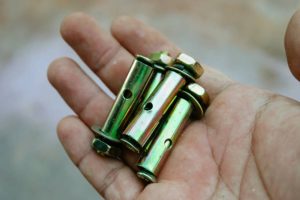Are you ready to learn how to use hollow wall anchors? Don’t worry—it’s easier than you think! Hollow wall anchors are little tools that help you hang things on walls without the screws falling out. Whether you’re putting up a shelf, a picture, or even a TV, hollow wall anchors make sure it stays on the wall securely.
Today, we’re going to walk you through 10 easy tips to help you use hollow wall anchors correctly. Let’s make this fun and simple so that anyone, even kids, can follow along!

1. Find the Right Spot
Before you start anything, you need to choose the perfect spot for your wall anchor. Why? Because once it’s in the wall, it’s hard to move without damaging things.
Think about where you want to hang your item. For example, if it’s a picture, find a spot that’s eye-level. For heavier items like shelves or a TV, make sure you pick a strong part of the wall. Tap the wall lightly with your knuckles; a hollow sound means it’s a space, and that’s where a hollow wall anchor can be helpful.
Tip: Double-check your chosen spot with a tape measure or pencil to ensure your item will be centered and look just right.
2. Use an Appropriately Sized Drill Bit
Once you’ve found the right spot, it’s time to grab your drill! But wait—don’t just use any drill bit. The size of the drill bit needs to match your wall anchor size. If the hole is too big, the anchor will fall right through. If it’s too small, the anchor won’t fit.
Check the package of your hollow wall anchors. It will usually tell you the right size of the drill bit to use. For example, if your anchor needs a 5mm hole, use a 5mm drill bit. This step ensures a snug fit.
Tip: If you’re not sure which size to use, start small. You can always make the hole bigger, but you can’t make it smaller!
3. Prepare the Screw and Anchor
Now that you’ve drilled your hole, it’s time to prepare your screw and anchor. Gently push the hollow wall anchor into the hole. It should go in smoothly, without too much force. If you’re struggling, you might need to drill a slightly larger hole.
Once the anchor is in the wall, grab your screw. Don’t push it into the anchor yet—just make sure it’s lined up properly.
Tip: Some anchors might expand inside the wall to hold onto the back. When you turn the screw later, it helps the anchor stay in place.
4. Secure the Anchor
Now comes the important part—securing the anchor! To do this, carefully tighten the screw into the anchor. You can use a screwdriver or a drill, but be gentle. You want the screw to go into the anchor, but you don’t want to break the wall around it.
As you tighten, the anchor will grip the inside of the wall, locking it into place. This makes it strong enough to hold your item without falling.
Tip: If the screw is turning but doesn’t feel like it’s gripping, stop. You might have drilled the hole too big or the anchor might be spinning in the wall.
5. Drill the Screws
Now that your anchor is secure, finish by drilling or screwing the rest of the way into the anchor. Make sure it’s tight, but again, don’t overdo it. You want the screw to hold firmly without damaging the anchor or the wall.
Once the screw is in place, you can hang your picture, shelf, or whatever you’ve been working on. Feel free to give it a little tug to make sure it’s secure—just not too hard!
Tip: If you’re hanging something heavy, make sure you’re using the right type of anchor for the job. Some anchors are designed to hold more weight than others.
6. Check the Wall Type
Not all walls are the same! Some walls are drywall, some are plaster, and others might be brick. Before using your hollow wall anchors, double-check what kind of wall you’re working with.
Hollow wall anchors are made specifically for hollow areas, like drywall. If you’re working with a solid wall, you might need different tools, like masonry screws for brick or concrete.
Tip: If you’re unsure about your wall type, tap it lightly with your fingers. Hollow walls will sound, well, hollow. Solid walls will have a firmer sound.
7. Use a Level
Before you start drilling, use a level to make sure your item will be straight. Nobody likes hanging a picture or shelf only to realize it’s crooked!
Hold the level where you want to place your screws and adjust until the little bubble is centered. Mark the spots where the screws will go with a pencil. This way, when you put in your hollow wall anchors, everything will be perfectly straight.
Tip: If you don’t have a level, you can use a ruler or even a smartphone app to help you keep things straight.
8. Double-Check Weight Limits
Every hollow wall anchor comes with a weight limit. This means there’s a maximum amount of weight it can hold safely. Make sure the anchor you choose can handle the weight of what you’re hanging.
If you’re hanging something light, like a picture frame, most basic anchors will do. For heavier items like shelves or TVs, you’ll need stronger anchors designed for more weight.
Tip: Don’t guess! Always check the packaging for the anchor’s weight limit and compare it with the item you’re hanging.
9. Use Multiple Anchors for Heavy Items
If you’re hanging something really heavy, like a large mirror or a shelf full of books, it’s a good idea to use more than one anchor. Spreading the weight across multiple points on the wall helps prevent any one anchor from being overloaded.
For example, instead of using one anchor in the center of a heavy shelf, use two or three anchors spaced evenly apart. This makes your shelf more stable and secure.
Tip: Always measure carefully to make sure the multiple anchors are evenly spaced and lined up.
10. Remove Anchors Safely
Sometimes, you might need to remove an anchor, whether it’s because you’re redecorating or moving. Removing hollow wall anchors carefully is important if you don’t want to leave a huge hole in your wall.
To remove an anchor, unscrew the screw first. Then, gently try to pull the anchor out with pliers. If it’s stuck, push the anchor into the wall using a screwdriver. You can fill the hole with some spackle or putty to make it disappear.
Tip: Don’t rush when removing an anchor. The slower and more careful you are, the less damage you’ll leave behind.
Conclusion
Using hollow wall anchors can seem tricky at first, but with these 10 easy tips, you’ll be a pro in no time! Remember, the key to a successful job is preparation. Always choose the right spot, the right size drill bit, and the right anchor for your project. And don’t forget to check your wall type and weight limits before you start.
By following these simple steps, you can hang anything on your walls with confidence, knowing that your items are safe and secure. Whether it’s a lightweight picture frame or a heavy-duty shelf, hollow wall anchors make the job easy and reliable.
Happy hanging, and if you ever need help, don’t hesitate to call Eagleriver Painters. We’re here to assist with all your home improvement needs—from painting and plumbing to electrical work and drywall solutions. We’ve got you covered!
